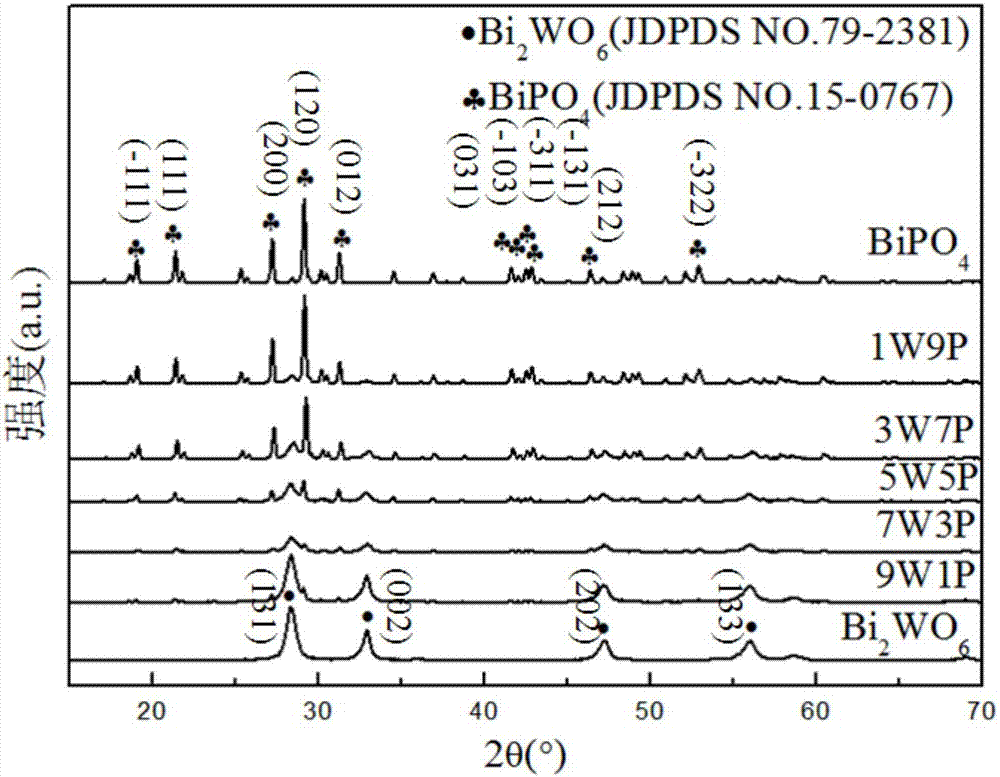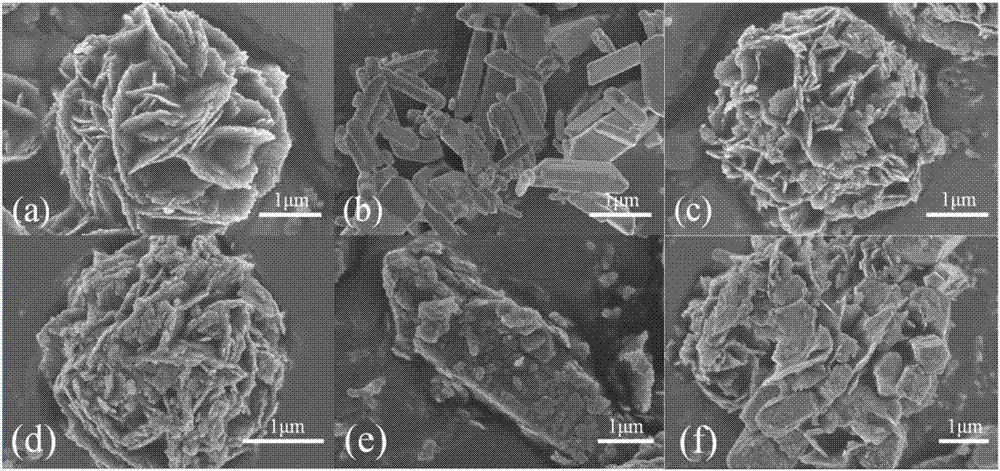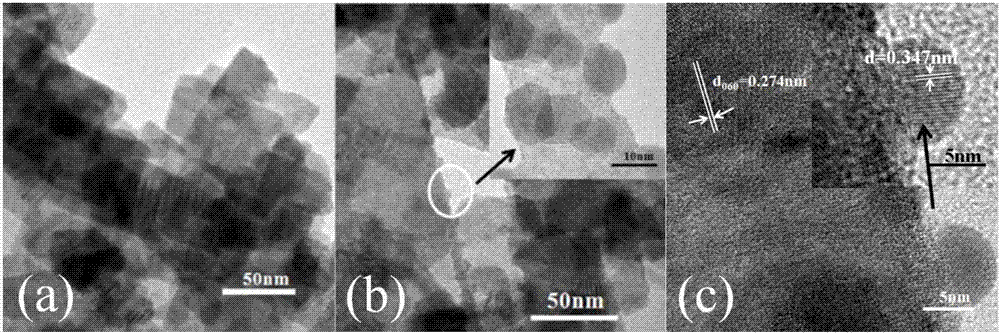Bismuth tungstate/bismuth phosphate heterojunction photocatalyst and preparation method and application thereof
A photocatalyst, bismuth phosphate technology, applied in physical/chemical process catalysts, chemical instruments and methods, water/sewage treatment, etc., to achieve high crystallinity, improved photocatalytic performance, and good photocatalytic performance
- Summary
- Abstract
- Description
- Claims
- Application Information
AI Technical Summary
Problems solved by technology
Method used
Image
Examples
Embodiment 1
[0033] Step 1: the raw material 3mmol Na 2 WO 4 and 6mmol Bi(NO 3 ) 3 Dissolve in deionized water, stir vigorously for 20min to obtain a white mixed solution, the concentration of Bi element in the mixed solution is 0.133mol / L, ultrasonically disperse the mixed solution in an ultrasonic instrument with a power of 400W for 30min, and then at room temperature with 300rad / L Min speed magnetic stirring for 2 hours, and finally transferred to a hydrothermal reaction kettle with a microwave power of 300W, microwave hydrothermal reaction at 180°C for 1 hour, and a white mixed solution was obtained. The precipitate was washed three times with absolute ethanol and deionized water, and dried at 80 °C for 15 h to obtain white Bi 2 WO 6 Powder;
[0034] Step 2: Add 3mmol Na 3 PO 4 , 3mmol Bi(NO 3 ) 3 and 5mL of 1mol / L nitric acid solution were dissolved in deionized water, and after stirring, a white mixed solution was obtained. The concentration of Bi element in the mixed soluti...
Embodiment 2
[0037] Step 1: the raw material 3mmol Na 2 WO 4 and 6mmol Bi(NO 3 ) 3 Dissolve in deionized water, stir vigorously for 20min to obtain a white mixed solution, the concentration of Bi element in the mixed solution is 0.14mol / L, ultrasonically disperse the mixed solution in an ultrasonic instrument with a power of 500W for 20min, and then at room temperature at 350rad / L Magnetically stirred for 1.5 hours at a speed of min, and finally transferred to a hydrothermal reaction kettle with a microwave power of 300W. Microwave hydrothermal reaction was carried out at 190°C for 0.8 hours to obtain a white mixed solution. The mixed solution was left to stand for stratification, and the supernatant was removed. , the precipitate was washed three times with absolute ethanol and deionized water, and dried at 75 °C for 18 h to obtain white Bi 2 WO 6 Powder;
[0038] Step 2: Add 3mmol Na 3 PO 4 , 3mmol Bi(NO 3 ) 3 and 4mL 1mol / L nitric acid solution were dissolved in deionized water...
Embodiment 3
[0041] Step 1: the raw material 3mmol Na 2 WO 4 and 6mmol Bi(NO 3 ) 3 Dissolve in deionized water, stir vigorously for 20min to obtain a white mixed solution, the concentration of Bi element in the mixed solution is 0.145mol / L, ultrasonically disperse the mixed solution in an ultrasonic instrument with a power of 450W for 25min, and then at room temperature with 400rad / L Magnetically stirred at a speed of min for 1 hour, and finally transferred to a hydrothermal reaction kettle with a microwave power of 300W, microwave hydrothermal reaction at 200°C for 0.5 hours, and a white mixed solution was obtained. The precipitate was washed three times with absolute ethanol and deionized water, and dried at 70 °C for 20 h to obtain white Bi 2 WO 6 Powder;
[0042] Step 2: Add 3mmol Na 3 PO 4 , 3mmol Bi(NO 3 ) 3 and 4.5mL 1mol / L nitric acid solution were dissolved in deionized water, and a white mixed solution was obtained after stirring. The concentration of Bi element in the m...
PUM
| Property | Measurement | Unit |
|---|---|---|
| size | aaaaa | aaaaa |
Abstract
Description
Claims
Application Information
 Login to View More
Login to View More - R&D
- Intellectual Property
- Life Sciences
- Materials
- Tech Scout
- Unparalleled Data Quality
- Higher Quality Content
- 60% Fewer Hallucinations
Browse by: Latest US Patents, China's latest patents, Technical Efficacy Thesaurus, Application Domain, Technology Topic, Popular Technical Reports.
© 2025 PatSnap. All rights reserved.Legal|Privacy policy|Modern Slavery Act Transparency Statement|Sitemap|About US| Contact US: help@patsnap.com



